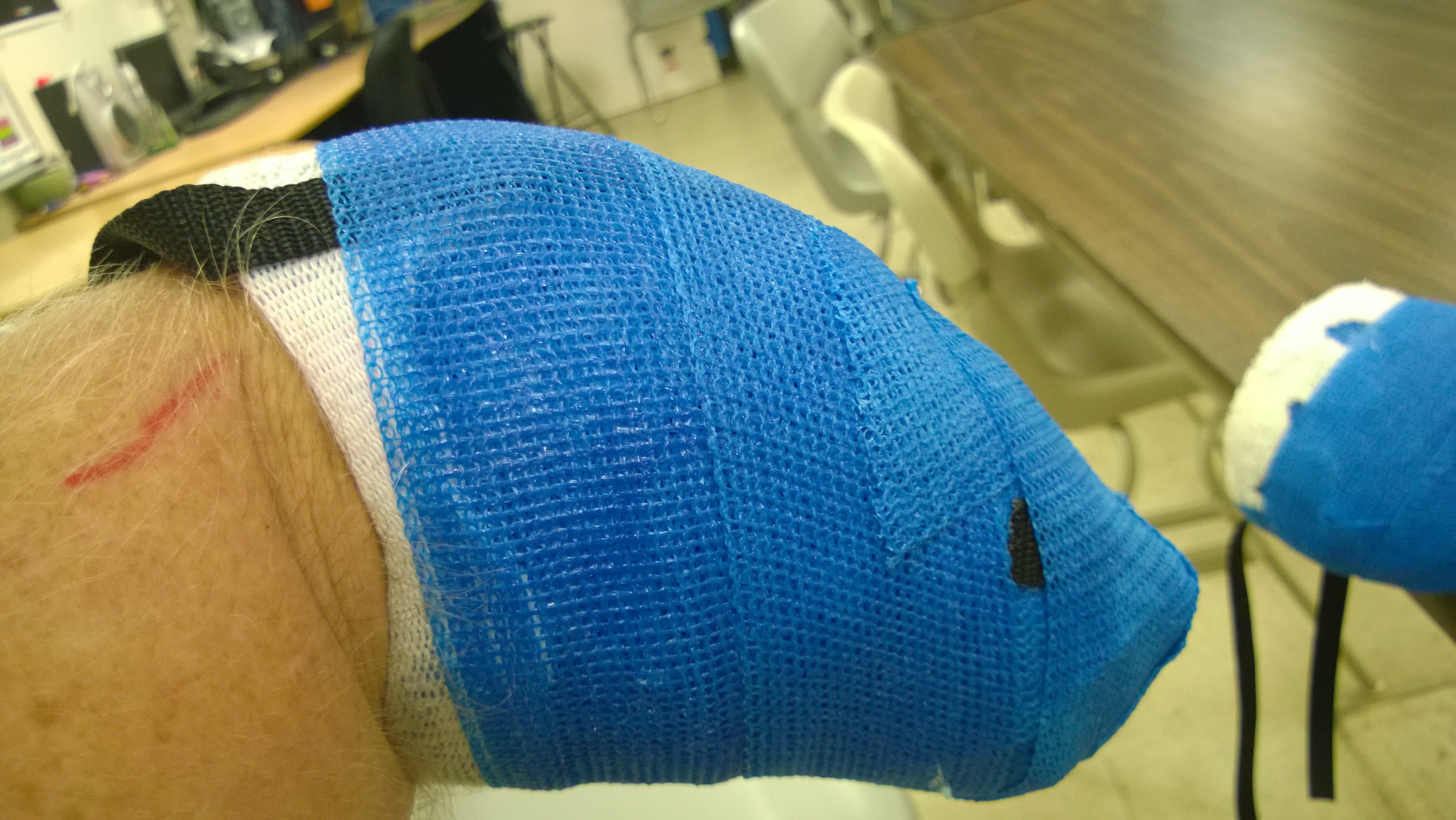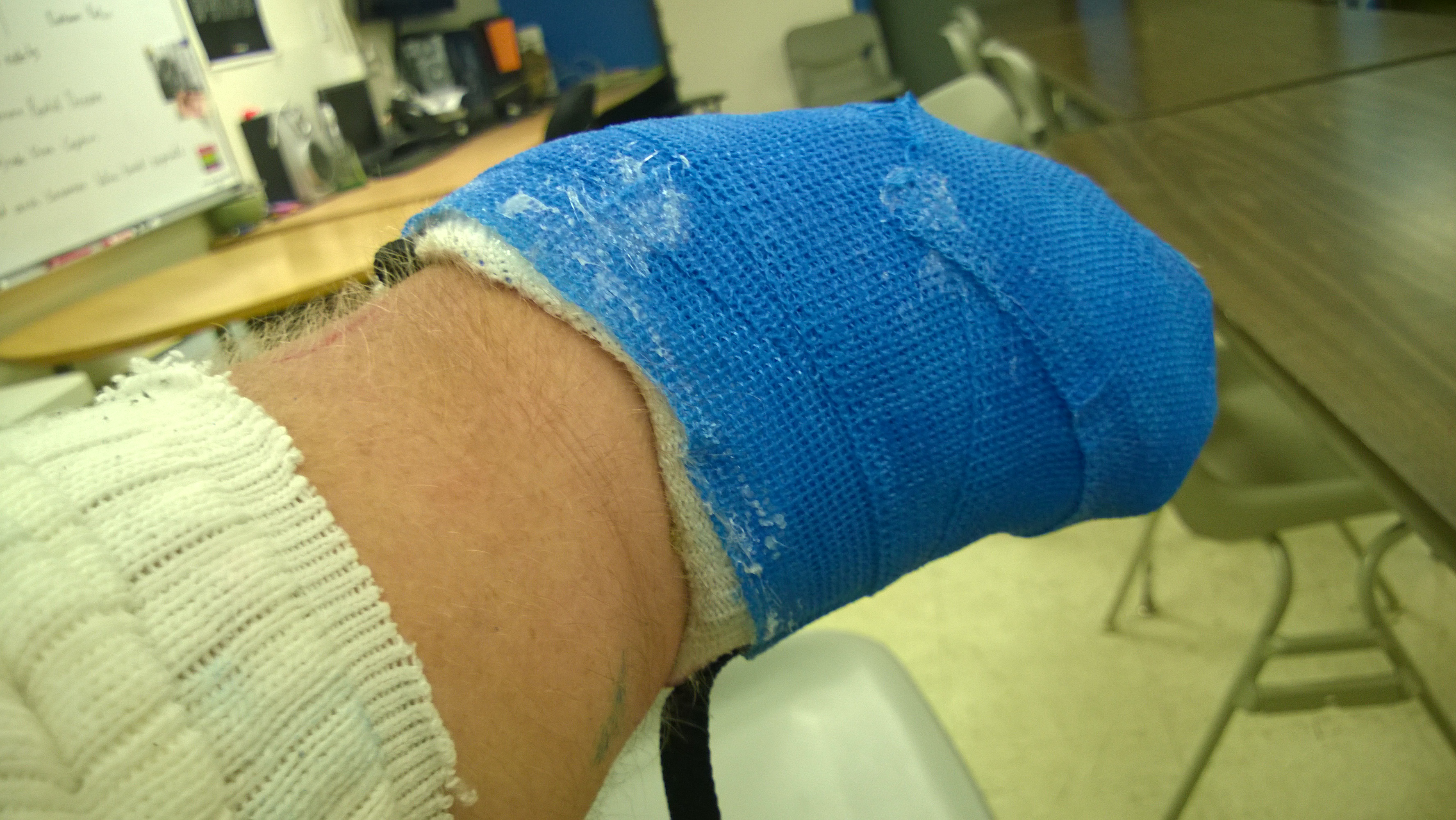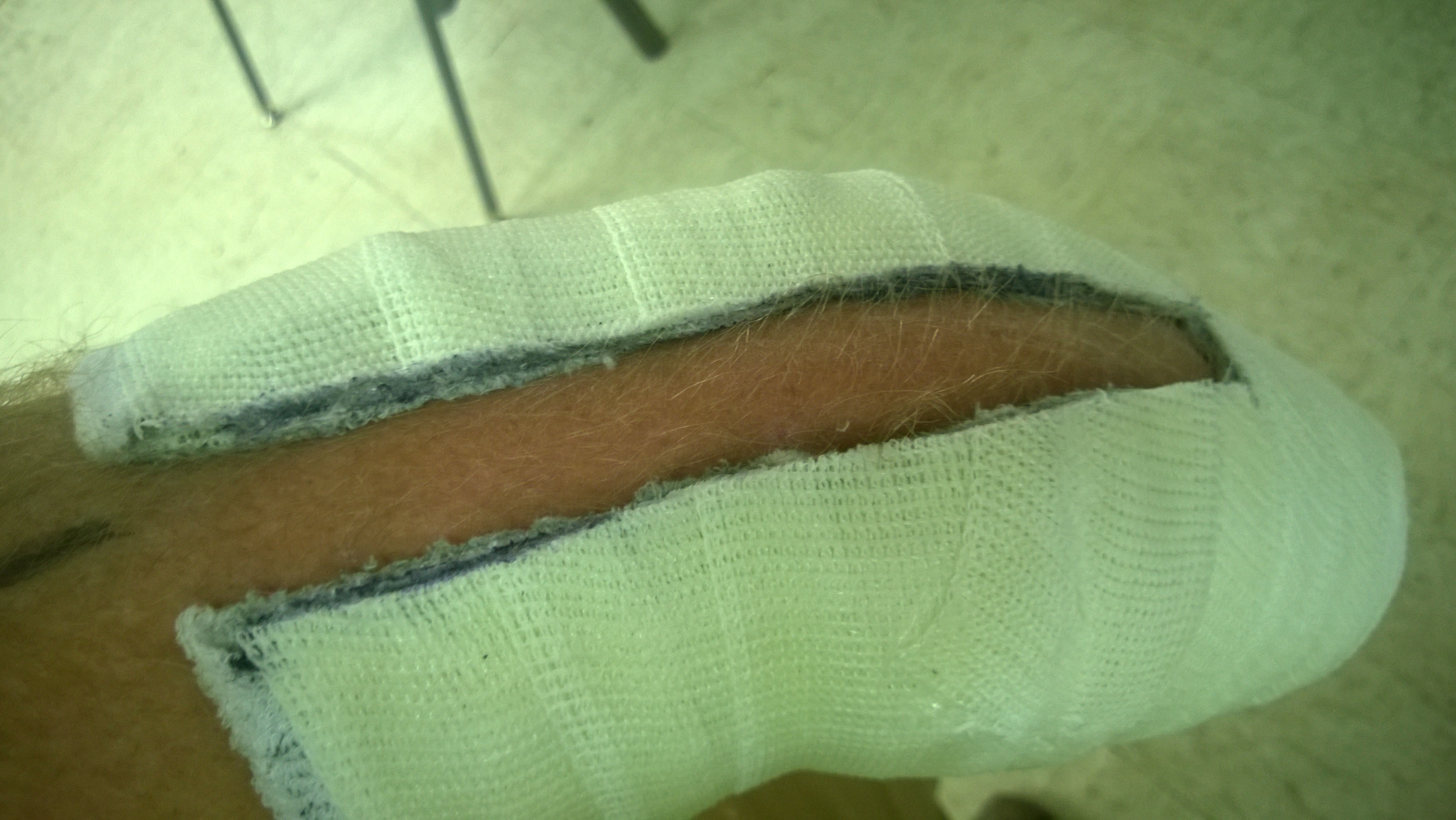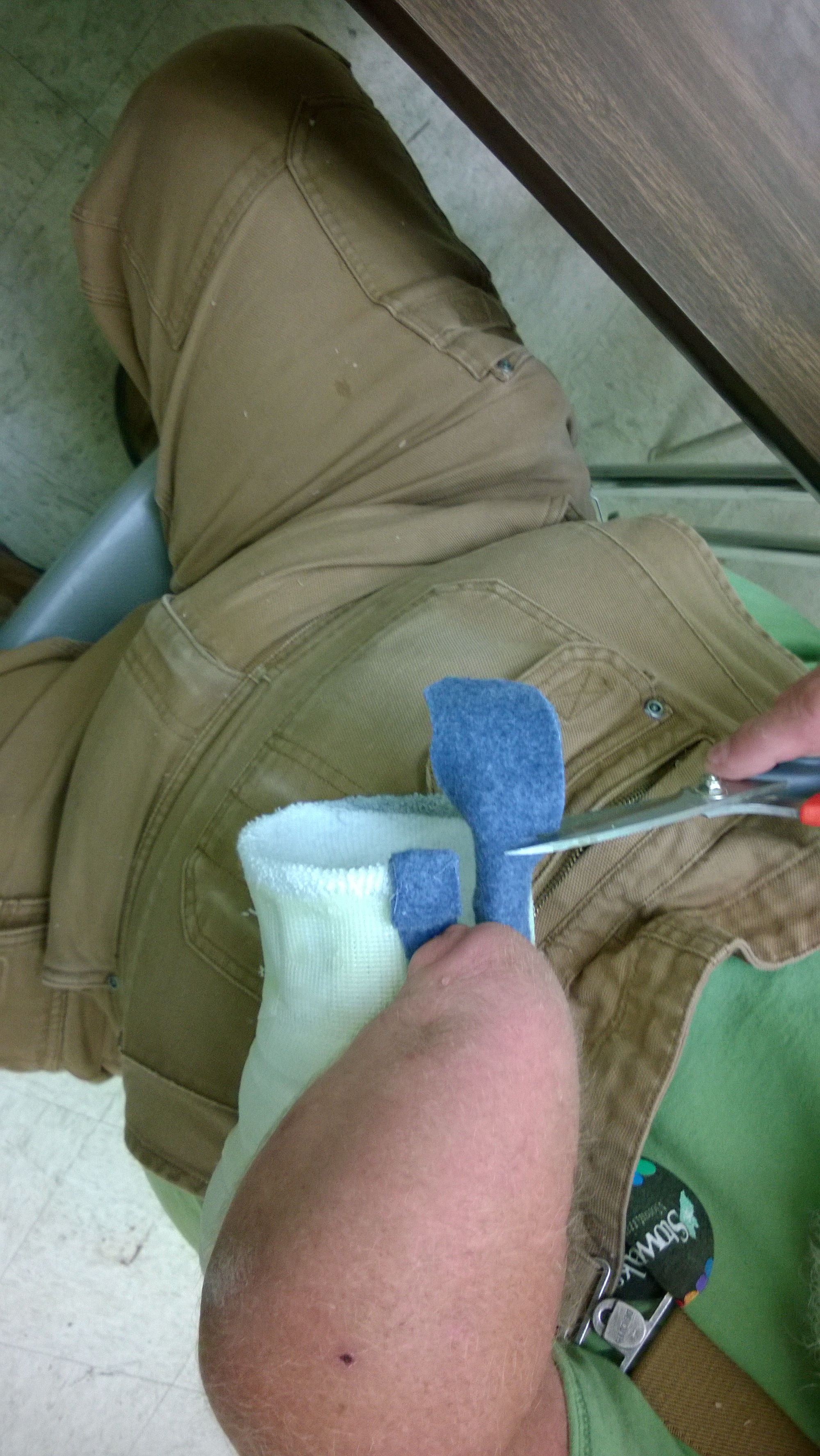Fuzzy Stump Socket Prosthetic
by mr_bandit in Circuits > Wearables
6786 Views, 27 Favorites, 0 Comments
Fuzzy Stump Socket Prosthetic

.jpg)
.jpg)
.jpg)
.jpg)

I was born without a left hand, and only have about 0.5 of my left forearm. Thanks to my parent's wisdom, they ignored that minor issue. Also, my daddy never met a child labor law he paid attention to. As a result, when I was a teen, we doubled the size of our house and I was grunt labor. I am now an engineer and build houses for a hobby, as well as a maker of various things. (I have several other Instructables.)
As an added bonus, I have (ahem) second-hand shop, filled with (sic) off-handed puns. Think about my name "bandit" for a minute or two.....
Aside from doing whatever I want to do (which has included rock climbing (5.7 lead), water and snow skiing, football in high school, woodworking, etc), about 75% of stuff you do I do the same way. Most of the rest of stuff I do takes a bit of creativity - I have a built-in hobby. (I find it interesting people around me forget I only one hand. My wife of 25+ years even forgets which hand I have or don't have.)
I have made my living as an embedded systems engineer. I type about 40..50 WPM, but I have never made it past page 2 of any typing manual I have seen... While I only play EE on TV, I have built a fair amount of hardware. Robots are a favorite. One of the best tools I have is an oscilloscope. Been soldering since I was 6 or 7. I have probably written in the neighborhood of 1 million lines of code, most of it in C for mission-critical systems. I have been on at least 3 or 4 projects that have changed the world. Of course, there are a lot of engineers out there who can (rightly) say the same thing. Be in the biz enough, and be fairly good, and it will happen. Point is, having one hand is not a handicap. Attitude is important. Not looking for praise or pity.
I also loath and detest normal prosthetics - they handicap me, not to mention being bloody dangerous. I had one in 5th grade because I thought it would make me "normal". Nope. I clocked a kid who was picking on me. A teacher called my father, who asked who started the fight. It was the other kid. My father asked, rather indignant, why they were not calling *that* kid's parents. I recognized I could really do a damage with the stinking thing, and it was not making me "normal".
A rant: I am also strongly against well-meaning folks who are 3d printing "hands" for kids born without a hand. Bless their hearts, they are doing it so the kids will "not be disabled". The kids are not "disabled", they just have one hand. The 3d printed "hands" are, at best, weak grippers that will break easily. You can hit one of mine with a hammer and it would not care. I am putting this project out there as a viable alternative to their "helping the poor crippled children". Bah. If they had approached my father with their "hand", he would have told them to stuff it. And rightfully so.
There are only two things that are a right pain: buying *one* glove, and holding a chisel/punch/etc - stuff that, by their nature, are inherently two-handed. In the past, duct tape and a sock have been my "goto solution". (Duct tape... bright shiny....)
Making a long story short, about 30 years ago I had a check socket for a prosthetic. For those who do not know what that is: first, a cast is made of the stump - a negative. That is then use to make a positive out of plaster of paris, with a pipe in the base. This positive is then used to vacu-form a check socket out of 1/4" polyethylene sheet, which is used to check the fit on the stump (hence the name "check socket"). (The polystyrene can be heated and gently molded to improve the fit.) This socket then creates a positive, which is used to form the fiberglass negative for the actual prosthetic. 3d scanning and modern tools are helping improve the art.
For those serious makers out there, a trip to a local prosthetic maker (slipping them a nice tip for their time) is well-worth the effort. They have *really cool* tools and techniques.....
Flash forward. I wanted something that was cheap (so I would not care if it got trashed), tough (so trashing it would be hard to do), and easy to make. Good, fast, cheap - choose any two. I got 2.5 of that mantra.
Depending on the materials, this should be in the range of $10 to $20 per unit. I got everything on Amazon (except for the liquid rubber, but I didn't check).
I am explicitly doing the "attribution, non-commercial" license, but anybody who wants to make it for themselves is more than welcome to. Drop me a note in the comments.
AND - I want to get this into the toolbox of the Veteran's Administration. Any vet out there who is one (or two) hands shy is *more that welcome* to spread this around. (And God Bless you. The word "Thanks" is far too simple and highly inadequate. If this helps even one vet, I am sincerely humbled to help.)
Materials and Tools



.jpg)
.jpg)

Material:
- 2-inch 4-yards fiberglass cast material
- several yards of 1/2-in flat nylon webbing
- several yards of 2-inch flat nylon webbing
- several yards of sticky pile-side velcro
- several yards of normal hook-side velcro
- several yards of normal pile-side velcro
- a can of Liquid rubber
- Foam brush (for the liquid rubber - you will throw this away)
- hot glue sticks
- socks
- 1/2-in "D" rings
- surgical gloves
I know - several yards of velcro and flat webbing seems excessive. Trust me - it comes in handy...
Tools:
- Hot glue gun
- Sewing Machine
- scissors
- fire stick (bic lighter)
- sharpie
What the Base Unit Looks Like
.jpg)
.jpg)
.jpg)
.jpg)
.jpg)
This is the "base". It is the result of the steps.
The shot of the two: prototype #2 is on the right; #3 on the left. #1 was a complete loss: I used 4-in cast material, which is why I now use 2-in material.
First Layer
.jpg)
.jpg)
.jpg)
.jpg)
Wear gloves!. It took me two days to scrub the resin off my hand. The slick surface is weird feeling....
First layer:
- Put a sock over the stump
- Wrap it with 2 yards of fiberglass cast material (half of a 4-yard roll)
- you should have a basin of water ready
- Using a hand, help mold the cast onto your stump
- Repair any loose flaps with hot glue
- For folds that stick up, cut a V and hot glue it down
It helps to have someone help with this step. As soon as the first half of the cast material is cut, put the rest of the roll into a zip-lock baggie and suck the air out before sealing. The resin is *very* hydrophilic - it will suck the moisture out of the air and start setting up. You need it for the second layer.
Also - keep in mind the bend of the inside of the elbow. Be able to bend it without the cast digging in...
Look on youtube for instructions for making a (ahem) short arm cast. (I can always tell ex-military when I say I can pass two short-arm inspections.)
Note the normal method is to dunk the entire roll in water. We don't (usually) want to do that, at least on the first 2 yards. Instead, have a basin of water (straight from the tap is fine), and dunk the strip into the water a couple of times. You can try rolling up the 2-yard strip, but I found it does not matter as long as you can handle the strip. You might trash the first roll, but they are cheap enough to experiment with.
Fold the Sock and Hot Glue It Down
.jpg)
.jpg)
.jpg)
.jpg)
.jpg)
.jpg)
When the first layer sets up:
- cut the sock 2..3 inches past the cast edge
- fold the sock over the lip
- Hot glue the sock down
Add the Straps
.jpg)
.jpg)
.jpg)
.jpg)
.jpg)
Add the straps which holds the cast to your stump
- put the cast back on your stump
- mark where you want the 1/2-inch webbing on the cast and your arm
- hot glue the 1/2-inch webbing so it goes over the end of the cast and each other
Second Layer
.jpg)
.jpg)
.jpg)
.jpg)
.jpg)

.jpg)
Second layer
- Put the cast back on your stub.
- Take the roll out of the baggie
- Apply around the cast fairly tight
- Make sure to overlap both the straps and the folded-over sock
- Mold as needed with your hand
- Let it set up
The resin binds fairly well to the sock. This is what the interior looks like for both of my prototypes.
If You Are Applying Velcro

.jpg)
.jpg)
.jpg)
.jpg)

You have a choice at this point. You can leave it alone (see a later step).
If you want to put sticky back pile-side velcro, you will need to cover the fiberglass with liquid rubber. I found this stuff in Lowes. The bigger hardware stores carries something similar.
Use the foam brush. It is not worth trying to clean the brush. Just make sure the brush width fits the can.
You will need to mount or otherwise hold the cast to both apply the liquid rubber and for it to dry. Do this in a well-ventilated area!!
The can I got was about $8 and is enough for four (4) of mine.
The reason you see two casts is they are my #2 and #3 attempt. Practice helps.
Apply the Velcro
.jpg)
.jpg)
.jpg)
.jpg)
.jpg)
.jpg)
You now have a surface the sticky-back pile-side velcro will stick to.
I found that wrapping the velcro around the cast to have the best results, because you have the longest runs. See the pictures with the black velcro. The pattern for the white velcro did not have as good a results. Also, by wrapping around instead of base to tip is the hook-side velcro is generally the same direction of pile-side, so the forces against the pile sidedon't want to rip the pile-side off the cast.
The Above-the-elbow Wrap
.jpg)
.jpg)
.jpg)
.jpg)
.jpg)
.jpg)
.jpg)
.jpg)
.jpg)
.jpg)
I needed a "wrap" above my elbow to hold the cast on my stub.
I used the tops of the socks I had cut off. I took the 2-inch web and wrapped it around my arm to get the length. I then used the sewing machine to put the sock tops on as padding. The sewing machine had a hard time sewing on the 1/2-in webbing, so I used hot glue.
I also used hot glue for the short pieces holding the D-rings. First, I put the D-rings on a (roughly) 2-in strip, then glued the strip on the arm band.
NOTE: DO NOT put sticky-side velcro on the webbing and try to sew it. The sticky will get onto the needle and gum-up the thread. If you need, use a dab of hot glue.
There are other ways to do the arm band. I will update this when I can.
Example Use && Variations






.jpg)

.jpg)

These are some examples of usage.
You can put the hook-side straps in an "X" or two "U"s, one at the top and one at the bottom.
You can mold something to the curve of the cast and secure it with velcro straps. I would suggest putting sticky pile-side on the top of what you want to secure, then put the hook strap across the whole thing (see the drawing).
See the drawing with the double-ended "T" bracket. The bracket is bent into a "U" - the "T"s are then bent to the arcs needed to match the cast. You have at least two choices
- put sticky pile-side on the tops, and use hook side straps
- use a cast without the rubber coating and epoxy the "T"s onto the fiberglass
Why do the epoxy version?
- use a 1/4-20 bolt into a fixture you can rotate in two-axis, with a vice-grip welded to the other end to hold metal for blacksmithing
- Attach a quick-release (for example, the key ring with two loops and a quick release in the middle), a larger ring, and put a kayak through the ring. Make sure the quick release is set so you push away to release in case the paddle wants downstream and you cannot go that way
- Make a fixture to clamp onto a bow for archery
- etc, etc, etc
A stronger variation is to epoxy "elevator bolts" to each side (or "top/bottom"). Ace hardware is a good place to find them. You need to remove the coating on the flat side and roughen the face to assure the epoxy will bond. You can then attach a plate to both sides for a secure mount, and the vice-grip to that mount. (a future project).
I tried two styles - the bolts on the second layer, and the bolts on the first layer, with the second layer hiding the base of the bolts. Not sure if it really matters, but the one with the second layer holding the bolt base is neater looking.
NOTE: get the 5-minute epoxy! I did not pay attention and got one with an hour cure time. the bolts kept slipping down the epoxy, so I had to tape them in place.
What if you don't have the elbow?
You can put it on the upper-arm stub and the kind of "over the other shoulder" harness for normal prosthetics.
Please leave comments and suggestions!!!
Simplification - a One-piece Solution
.jpg)
.jpg)

.jpg)
.jpg)
.jpg)
.jpg)
.jpg)
.jpg)
.jpg)
.jpg)
.jpg)
.jpg)
.jpg)
.jpg)
.jpg)
.jpg)
.jpg)
.jpg)
.jpg)
.jpg)
.jpg)
.jpg)
.jpg)
.jpg)
.jpg)
.jpg)
.jpg)
.jpg)
.jpg)
.jpg)
.jpg)
.jpg)
I didn't really like the above-the-elbow holder, so I created some prototypes that are above the elbow. They need a split in order to get them on and off.
I did three prototypes with splits in different places (attached are pictures of at least two). They were: on the top, diagonal top to the outside; and on the outside.
The first two, I used a dremel tool and a steel cutting wheel. I knew I was getting close when I could feel heat. HOWEVER, I DO NOT recommend this technique. Instead, you can use a pair of scissors.
For the first layer, determine where you want the cut. Do this before you start the first layer wrap. Draw it on the sock to give you the general idea of where you want the split. Wrap the first layer. When solid enough, use a good pair of scissors to make the cut. Longer is better than shorter. Remove the whole thing, trim the sock to length (about 2-inches past the edge of the wrap), then cut the cast. Look at the pictures. The slot should be 0.5 to 0.75 inches wide. If you need to, cut the sock in the center of the slot and pul the edges over and hot glue them to the top of the layer. Fold the sock over the top, cut into "fingers" (as already described, and hot glue them.
Put the cast back on. If you need, use a rubber band above the elbow to keep the top of the slot at the same width as the bottom of the slot. Put the second layer on. Use the scissors to cut the second layer, take the cast off, and trim the top layer to the slot.
Take 1.5-inch strips of fleece that are a bit longer (inch or so) than the slot. Hot glue one edge to the inside of the slot. See the pictures. After the inside is hot glued, fold the fleece and hot glue to the outside. See the pictures. You want the fleece to hug fairly tight (meaning not loose) around the edge of the slot. I cut the fleece at the top even with the top of the cast edge, formed a flap out of the inside part, and hot glued it down. See the pictures. Do the other side of the slot in the same manner.
Create a strap with a D-ring or O-ring and 0.5-inch nylon webbing. Make the strap long enough it can go through the D-ring and fold back at least 3 to 5 inches. You can make it longer, and create a loop to pull on the strap to make it tighter. Sew velcro to the strap to hold the strap closed. Hot glue it around the top of the cast.
Another Technique

















These are elevator bolts - like carriage bolts, but with a flat head. You need to clean the head surface so epoxy will bond to it. They are only at Ace Hardware - I could not find them at Lowes or Home Despot.
Use epoxy to put them where you want. Draw where you want them with a big crosshair. The epoxy makes it hard to get exact positioning. If that is critical to you, make a simple jig.
My intent is to put 1/8-in steel bars where they would meet at the tip of the cast (follow the angle of the cast). Then weld a bolt pointing out. (If I have my arm straight out, it would be in-line, like I was pointing my finger at something.) See the drawing. Then weld a washer on the back end, put a tube on the bolt, a washer, a nut. This is one axis. Now take a bar and weld it onto the tube at the needed angle. On the other end of the bar weld vice grips at the right angle.
Why do this? If you get the right angle, you can use the vice grips to hold something you want to hit with a hammer on an anvil - like forging metal.
The ID of the tube should not have a lot of slop vs the OD of the bolt. You can/should use a thick-walled tube if you weld onto it. Black gas pipe can work. You don't need a really long bolt. When you weld the backing washer, you probably want to use the tube as a jig to get the washer angle right so the tube under tension has good contact with the washer. OR - cut the tube at a bit of an angle so the tube will not rotate against the washer that you weld at that angle.
The main thing with the angles of the bolt and from the tube to the vice grips is what is comfortable for what you want to do. PLEASE SEND ME YOUR APPLICATIONS IN THE COMMENTS.
Instead of a single bar, you can use two steel bars with a hole in each and a bolt through the hole. This allows you to adjust the angle the vice grips are at.
You can put the bolts on the first or second layer. If on the first layer, you can make the bolts pretty because you are covering the epoxy. That seems to be the only difference.
My next prototype will only use one layer with the elevator bolts.